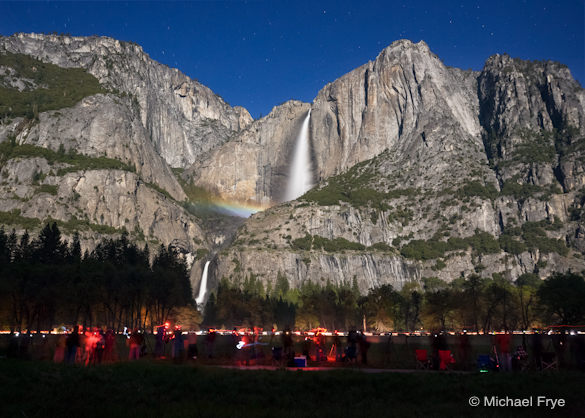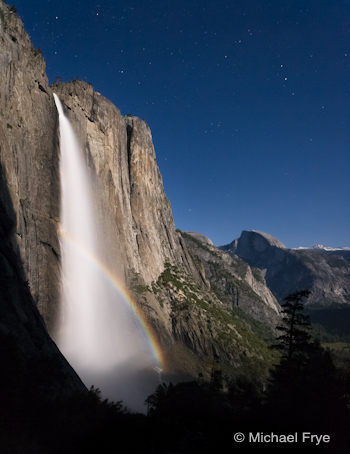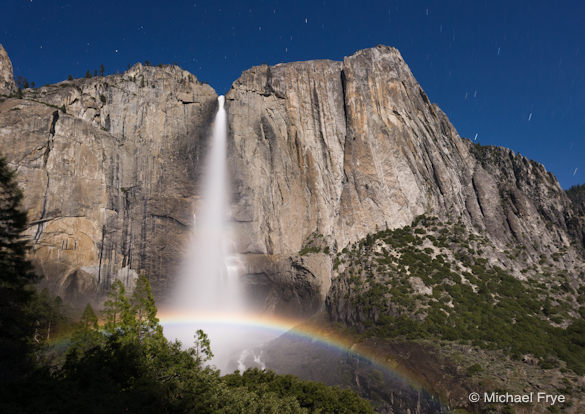I hope that saying, “Better late than never” is true—at least this time! I’ve been really busy the since the full moon, but here, finally, are some photos of the lunar rainbow from May 4th and 5th.
Large numbers of photographers headed to Yosemite Valley that weekend to photograph dogwoods and the lunar rainbow. At times I joined four or five photographers pointing lenses at the same dogwood, and there were at least 200 people in Cook’s Meadow on Saturday evening (May 5th) watching and photographing the lunar rainbow. The photo at the top of this posts shows the moonbow and some of those attempting to photograph it.
The previous night my friend Jon McCormack and I grunted up the Yosemite Falls trail to a spot with a profile view of the upper fall. I’d photographed a lunar rainbow from this spot in 1996, but back then I didn’t have a wide enough lens on my Mamiya 645 to include Half Dome and the whole waterfall, so I thought it was time to try it again.
I wasn’t sure there would be enough mist for a good lunar rainbow from this location, but just when the rainbow appeared the wind kicked up. This made it really cold, but also blew the spray around and made the waterfall look bigger, and the rainbow last longer. It turned out to be almost ideal conditions for this photograph.
It was a long night; I got home as dawn was breaking and birds were starting to sing outside my house in Mariposa. But Jon and I had a great time. It was wonderful hearing and seeing this huge waterfall from up close on a beautiful moonlit night.
I’ve seen some great photos from that weekend; if you have some you’d like to share, please post a link in the comments.
Another celestial event is coming up this Sunday: an annular solar eclipse will be visible over parts of northern California, Nevada, Utah, Arizona, New Mexico, and Texas, as well as many other parts of the world. If the weather cooperates the eclipse could be photographed fromd some beautiful locations, including Redwood, Lassen, Zion, Bryce, and Grand Canyon national parks, Monument Valley, Canyon de Chelly, and Chaco Canyon.
An annular eclipse differs from a total solar eclipse in that the moon isn’t quite big enough to block out the whole sun, so the outer ring of the sun still appears. You can see photos, maps, and a video on NASA’s site, and a video animation showing the path and timing of the eclipse here.
I wish I could give you some advice about photographing this eclipse, but I’ve never photographed a solar eclipse before, so I’m just gleaning information off the internet like everyone else. I found some useful articles here, here, and here.
The usual caution about solar eclipses applies: don’t look directly at the sun unless you’re wearing protective glasses. From descriptions I’ve read the sun might be bright enough, even during the darkest part of the eclipse, to cause lens flare—but I don’t know. The eclipse will occur near sunset in New Mexico and Texas, which will make the sun dimmer and help avoid potential flare.
I’m planning to head north for the eclipse, though I’m not sure where yet. Maybe Lassen, but I’ll check the weather reports first. If you try photographing the eclipse let me know how you make out!
—Michael Frye
Related Posts: Lunar Rainbow Season, and a Dogwood Update
Michael Frye is a professional photographer specializing in landscapes and nature. He is the author and photographer of The Photographer’s Guide to Yosemite, Yosemite Meditations, and Digital Landscape Photography: In the Footsteps of Ansel Adams and the Great Masters, plus the eBooks Light & Land: Landscapes in the Digital Darkroom, and Exposure for Outdoor Photography. He has written numerous magazine articles on the art and technique of photography, and his images have been published in over thirty countries around the world. Michael has lived either in or near Yosemite National Park since 1983, currently residing just outside the park in Mariposa, California.












Wonderful images as always. My friend and I hiked to the top of Upper Yosemite Fall the night of the 4th, topped out about midnight and passed two photographers on the way down. I thought you might have been one of them because I thought I recognized your voice from your podcasts. I should have said hello! I passed the scene in the second photo because we were very tired and eager to get home, but seeing how amazing and unique that second shot was makes me wish I had taken 10 minutes to snap a few frames. But it was a beautiful moonlit hike, it was my friend’s first view of a moonbow and overall an unforgettable experience. Now I’ll just visit this page when I want to remember how this scene looked!
I remember seeing two people headed down the trail, one with a tripod. We were on the switchbacks near the base of the upper fall, and one of the people we met said there was a nice view of the moonbow from about 200 feet up the trail. Turned out to be a little further than that! 🙂 But it was a nice view. The second photo here was from a higher, drier spot. Anyway, was that you?
Sure was! That night hike was incredible.
Yes it was! Well it’s nice to know who I met up there. 🙂
Great work as always, Michael! I especially enjoy the shot of all the photographers in Cooks Meadow. It’s a pity I didn’t run into you on the Upper Fall trail. Here’s my shot from that night. http://500px.com/photo/7345963
Great photo Brian! Are you sure we didn’t run into each other? I did see three other photographers near the spot where your photo was taken, though it looks like your image was made a little later.
Hi Michael, lovely set of images as always. It was a lot of fun hiking up the falls with you.
Thanks Jon, and I was glad you could join me that night – tons of fun.
The second one is pretty cool, Michael! Sounds you guys had some fun out there…
Here´s a link to Miloslav Druckmüller, rated to be the best solar eclipse photographer today. There is a description to most of the images by clicking on them:
http://www.zam.fme.vutbr.cz/~druck/Eclipse/Ecl2010t/0-info.htm
Werner
Thanks for the link Werner – very helpful!
Hi Michael,
I hope all is well with you. I love the first shot because of all the people in the foreground. Showing them caused me to think about all the noise in our lives and how distracting it can be, but the beauty of nature’s canvas is never distracting.
Well done!
Todd
Thanks very much Todd!
I really like the shot from the upper falls trail. I’ve been planning to attempt something similar for a while. I was part of the crowd on Saturday night, and the lower falls area was a particular zoo. If anyone is interested, here are some shots of upper and lower falls that night.
http://www.flickr.com/photos/imageskylejones/7216369340/
http://www.flickr.com/photos/imageskylejones/7216369406/
I plan to be on the Eastern side of Mt. Shasta for the eclipse and am hoping to manage a decent composition with the mountain. Either way I’ll enjoy just having a chance to see it.
Thanks Kyle, and nice work with your moonbow photos. The east side of Mt Shasta sounds like a good spot, hadn’t thought of that…
Wow..Michael..I didn’t realize you were shooting right behind me on the Cook’s Meadow that evening!! I would love to see a hi-res version of the top picture with photographers shooting the moonbow..I can see the blue cooler box (with white lid) in the middle of the frame..and I was standing right next to it 🙂
Raja, you’ve been immortalized! Or at least your cooler has. 🙂 I posted a slightly larger version of that photo on Google+:
https://plus.google.com/108901599657368504920/posts/h3ZXW4mfDc3
Hi Michael,
Below is my link to 60 min star trails taken from Cook’s Meadow that night..
http://www.flickr.com/photos/52972930@N07/7172575808/
Very well done!
Nice work as usual Michael and lots of excellent information – always appreciated. Here is a link to a shot taken by my friend Denis which I think is quite good. http://www.flickr.com/photos/markbaha/7218618710/in/photostream
Denis just started a Flickr account which can be seen here http://www.flickr.com/photos/76874641@N05/
Thanks Mark! Denis did well.
Nice images, Michael. I specially like the one from the Yosemite Falls trail. Apart of the moonbow, it shows well how strong the moon was. Yosemite Falls is well illuminated compared to Half Dome which is in the shade.
I was surprised how many people where up at cooks meadow the night of May 5th. It looked almost like a Horsetail Fall shoot. I was on the other side of the Merced river to get a bit of a reflection as well: http://blog.leu.org/2012/05/yosemite-falls-moonbow-take-2.html
Maybe next year I’ll try the strenuous Yosemite Falls trail to get a different perspective.
Thanks Daniel, and congratulations for finding a different view near the crowds – nicely done!
Very nice shots of the moonbow. I almost went that night to see if I could improve upon moonbow shots from previous years. Judging by the crowd it was probably better I didn’t go. Were there many folks positioned near the chapel?
Thanks Houston. I didn’t go over to the chapel during the peak moonbow time, so I don’t know how many people were there. I’m sure less than in Cook’s Meadow.
Hi Michael,
Love the moonbow photo from the Upper Yosemite Falls Trail.
Definetly worth busting a lung to get that shot! 🙂
I got into Yosemite around 1am this morning, after taking
3 planes and a 2 hour drive afterwards 🙁
Heard about the eclipse this morning.
Yosemite most likely won’t be the ideal location to shoot the eclipse.
But … Do you think that Washburn Point or Sentinel Dome would be the best locations for shooting the eclipse?
Looking forward to a great week in Yosemite!
Time for me to get some supplies, then head out to shoot at some PM locations I have mapped out.
Take care.
Paolo
sent from my iPod
Thanks Paolo! You’ll only be able to see a partial eclipse from Yosemite. To see the full eclipse you’d have to be further north or east. A partial eclipse is difficult to photograph, though shadows underneath leafy trees during a partial eclipse can be quite interesting. The peak of the eclipse will be at 6:30 p.m., so the sun will be almost due west. Washburn Point looks east. Sentinel Dome would be a good spot to view the partial eclipse with the right goggles, but no tree shadows there. Hope you have a great trip to Yosemite!
Wonderful shots of the moonbow, Michael. The one on Yosemite Falls trail is very nice…an angle I don’t see that often, probably because of the physical effort needed! I love seeing Half Dome in the distance.
Was thinking of you and your family when I heard about the fire in Mariposa…what sad news there!
Thanks Vivienne! Yes, the fire in Mariposa was a sad thing. I’m just glad it didn’t spread further.
I’m loving the shot of the falls with Half Dome in the background! Maybe I will make it up there for the next full moon … June 4th.
This was my first experience shooting the moonbow in Yosemite … so I totally enjoyed the crowd in cooks meadow and I’m sure I made a couple of lasting friendships … well worth being there for sure.
I made a couple of image that I like and thought I would share. One is in the slideshow on my website at http://www.johnjmcmullen.com … I think it’s the last image. I have not put this in another gallery yet so you have to suffer through all the other shots to see it. 😉
Another is posted on my blog and that link is http://blog.johnjmcmullen.com/wp-content/uploads/2012/05/IMG_2401-2.jpg
I like this shot a lot. It’s like cooks meadow being invaded by UFO’s.
Cheers! John
PS. I’m heading over to the valley for the solar eclipse … not sure what I’ll get … but then, I’m never disappointed spending time in Yosemite.
Thanks John, and I’m glad you enjoyed photographing the lunar rainbow. Both images are well done; I especially like the one on your blog with the traffic and lights.
Michael,
Will the falls have enough water for the first weekend in June? I was thinking of coming up and hiking the trail on Saturday night/ Sunday morning…
Nice captures by the way
Cheers,
Dan
Thanks Dan. It’s not likely that there will be enough water in early June. The water levels in Yosemite Valley have been declining rapidly.
Bummer.
I’m still gonna do something up there that weekend. Probably still go for the falls trail. I haven’t hiked it in close to 30 years.
Wow! The photographs are great and the view is so amazing. The rainbow, falls, mountains…..Wow!
Thanks Delbenson!
Hi Michael, all of the links in the article are pointing to pages displaying the date of May 20, 2012… just wanted to clarify the dates for the annular eclipse… thanks much!
Hi Janet – yes, I know the date is hard to find, but this post is from May 2012, so the annular eclipse was last year. 🙁
MIchael,
This is a wonderful post
Thank You
Thanks again James!